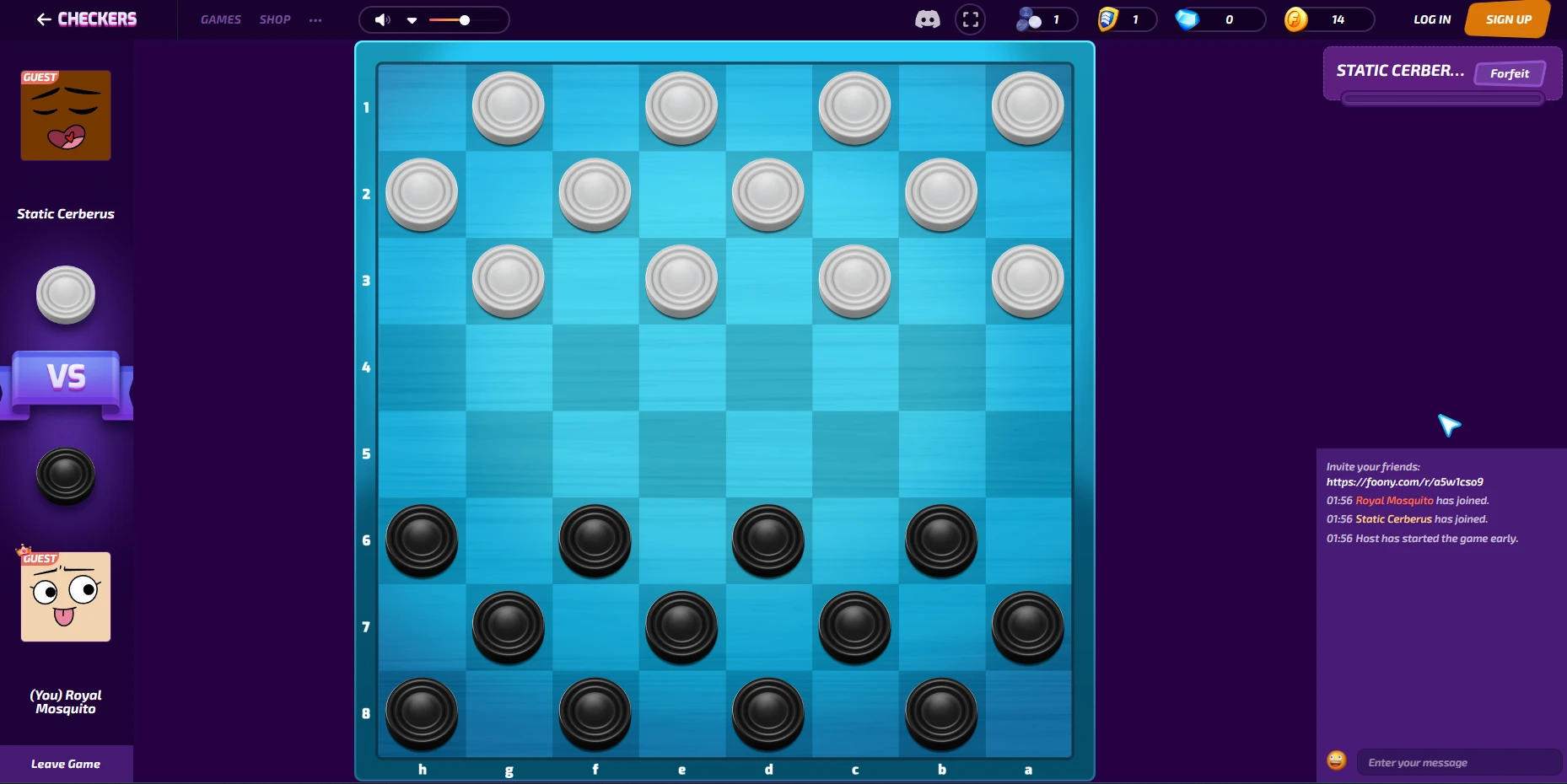








Rooms (0)
No public rooms.
Checkers Online - Draughts 2 Player Multiplayer Game
3.0
Rating
0
0
Checkers: Classic Strategy Takes On New Forms!
Sharpen your strategic mind with Checkers, the timeless game of captures and cunning moves. Outwit your opponents on the classic checkered board with a twist!
- Master the Basics, Conquer Variations: Learn the core rules, then explore exciting variations like Canadian Draughts, Russian Draughts, and more! Each offers unique twists to test your adaptability.
- Outsmart and Outmaneuver: Capture enemy pieces with clever jumps, block their advances, and set up cunning traps to claim victory.
- Challenge Yourself, Challenge the World: Track your progress and aim for the top of the leaderboards. Face off against friends or online rivals in thrilling strategic showdowns.
- Make It Your Own: Collect unique boards and pieces, or craft custom rulesets for a truly unique Checkers experience tailored to you!
Are you ready to put your strategic thinking to the test in a game with endless possibilities?
How to Play
Checkers is a board game that is believed to have originated in ancient Egypt and has since spread throughout the world. This famous board game is an old classic that’s still played by people of all ages for centuries. Checkers is a two-player game and is played on a square board with 64 squares arranged in an 8x8 grid. Each player controls a set of 12 pieces that are placed on the black squares of the board. The objective of checkers is to either capture all of your opponent's pieces or block them so they can no longer make a move. Players take turns moving their pieces diagonally on the board, with the goal of capturing their opponent's pieces by jumping over them which removes them from the game. If a player is able to reach the opposite side of the board with one of their pieces, that piece becomes a "king" and can move both forwards and backward, making it even more powerful. The game is easy to learn but can be incredibly challenging and strategic, making it a crowd favorite among players of all skill levels–great to play with friends and family.
The Setup

Setting up a game of checkers is very simple. To begin, you'll need a checkerboard, which is a square board with 64 squares arranged in an 8x8 grid. Each square is either black or red, and the players' pieces are placed on the black squares. You'll also need a set of 24 checkers, which are small, round pieces that come in two different colors–again usually red and black.
To set up the game, each player places their 12 pieces on the three rows of black squares closest to them. The pieces are arranged in an alternating pattern, with one color facing the other. You should have the three closest black rows filled up with your checker pieces. Once they’re set up, the game is ready to begin! To start the game, it’s usually the player with the black pieces that goes first. However, you can decide to either flip a coin or play a quick game of rock-paper-scissors to determine who starts.
How to Win
The objective of checkers is to either capture all of your opponent's pieces or block them so they can no longer make a move. “Blocking” them really means forcing a player to make a move that will result in them losing their final piece, similar to checkmate in chess. Players take turns moving their pieces diagonally on the board, with the goal of capturing their opponent's pieces by jumping over them.
If a player is able to reach the opposite side of the board with one of their pieces, that piece becomes a "king" and can move both forwards and backward, making it the most powerful and valuable piece in the game. Players can also choose to block their opponent's moves by strategically placing their pieces in key positions on the board–we’ll explain this in more detail later. The game ends when one player has captured all of their opponent's pieces or when their opponent is unable to make a move. Winning a game of checkers requires careful planning, strategic thinking, and the ability to adapt to your opponent's moves.
Jumping Rules
Jumping over a piece is a key mechanic that removes your opponent's pieces from the board. The rules for jumping are simple. If you have a piece that is adjacent to your opponent's piece and there is an empty square beyond that piece, you can "jump" over your opponent's piece and remove it from the board.
When you jump over an opponent's piece, you must land in an empty square on the other side. This can create new opportunities for you to jump again and capture additional pieces, creating a chain reaction of captures that can be very powerful.
However, there are a few important rules to keep in mind when jumping:
-
Forced jump. You must jump if you have the opportunity to do so. If you have a piece that can jump over an opponent's piece, you must take that opportunity. You cannot make a different move instead.
-
One piece at a time. You can only jump over one of your opponent's pieces at a time. If there are multiple pieces that you could jump, you must choose the one that will result in the most advantageous position.
-
Movement of kings. If you have a king on the board, it can jump forward or backward, giving you even more options for capturing your opponent's pieces. Kings can jump multiple pieces in either direction, and this differs from the basic pieces as they can only make forward jumps. In draughts, kings can move multiple spaces like a bishop in chess.
By creating chains of jumps and captures, you can reposition yourself while removing your opponent's pieces and gain a significant advantage. It's important to stay alert for opportunities to jump, while also keeping your own pieces protected from your opponent's jumps.
Ending in a Draw
Sometimes, a game of checkers can end in a draw. This can happen if both players are unable to make a move or if the same board position repeats itself three times. Players can either agree to end the game as a draw or play a tiebreaker game to determine the winner. When checkers is played in a tournament, a draw is automatically forced when there has been a total of 40 moves without a single capture.
Strategies for Winning
There are a number of different strategies that you can use to increase your chances of winning at checkers. However, keep in mind that no strategy ever guarantees a win. Here is a brief of some of the most effective ones:
-
Control the center of the board. The center of the board is the most important area in checkers. By controlling the center squares, you can limit your opponent's movement and force them to react to your moves. Try to move your pieces toward the center of the board early in the game and maintain control of these squares throughout the game.
-
Playing offensively. In the early stages of the game, newer players may tend to play more defensively instead of offensively. You want to apply pressure on your opponent and limit their options so you give yourself more opportunities to capture their pieces. Create strong positions for yourself and keep them on the defense.
-
Constantly look for opportunities to capture. It's important to always look for opportunities to set up and capture your opponent’s pieces. You want to set up your pieces in a way that makes it easy for them to capture pieces but also avoids being captured. Look for opportunities to use combinations, such as double or triple jumps to capture multiple pieces at once. Always keep in mind how you will end up repositioning after making jumps.
-
Create a "king row." Remember that getting one of your pieces to your opponent's back row will upgrade it to a king. This is a powerful advantage, as it allows your king to attack your opponent's pieces from multiple directions. Try to create a "king row" early in the game, where you have several kings lined up across the back row of the board. You may also want to leave your pieces in your own king row for as long as you can to prevent your opponents from getting their kings.
-
Keep your pieces connected. Keeping your pieces connected means that they are positioned in such a way that they can support each other and defend against your opponent's attacks. Try to keep your pieces connected as much as possible, while also keeping them spread out enough to avoid being captured by a single move. Doing this effectively will create blocks for your opponent, forcing them to make moves elsewhere.
-
Sacrifice at the right time. If you plan your moves carefully, sacrificing your pieces may be very beneficial for you. Try to think several steps ahead so you can force your opponent to make jumps that remove your pieces, but at the same leave you with even better positioning and opportunities to win in the later stage of the game.

